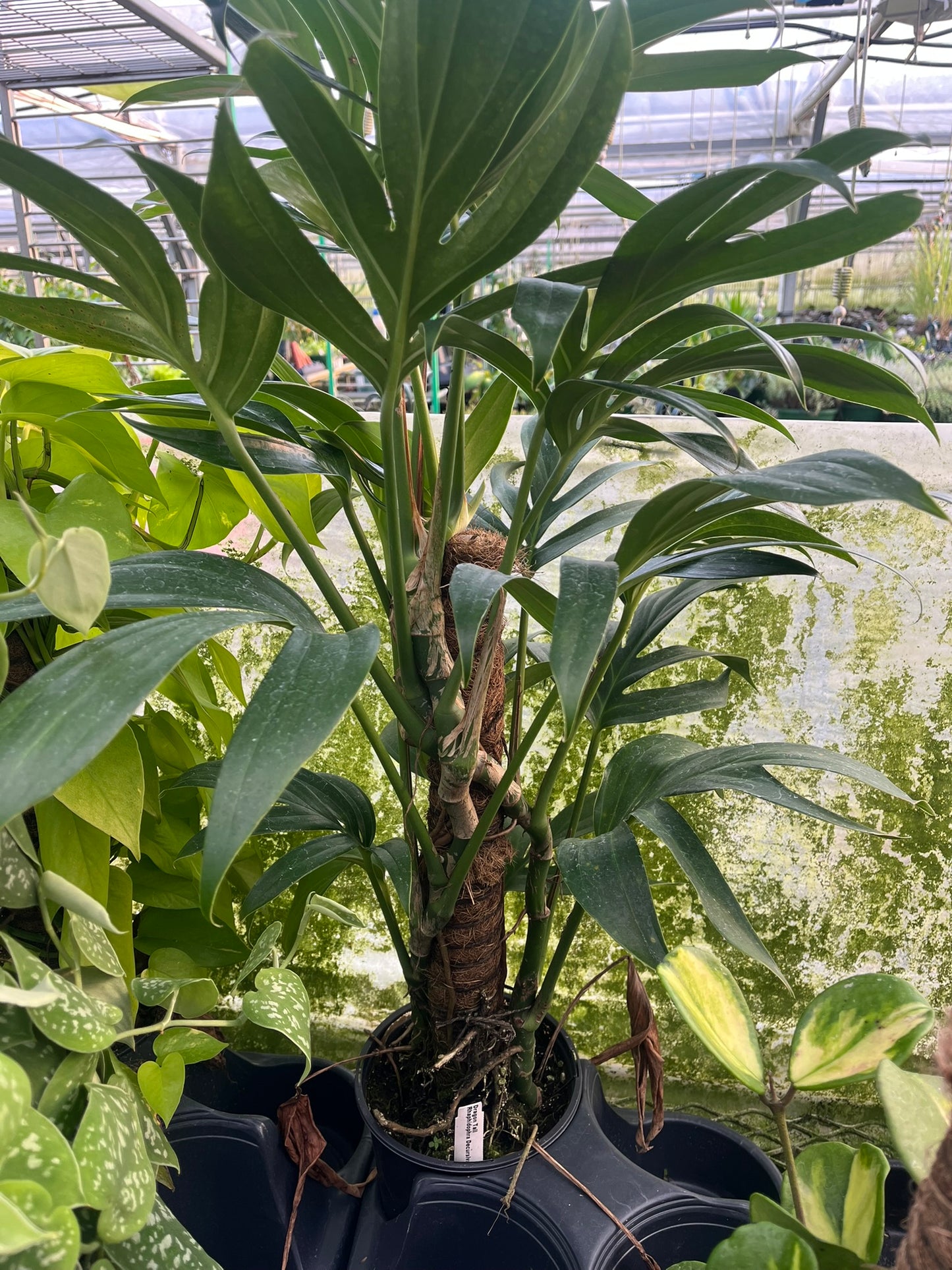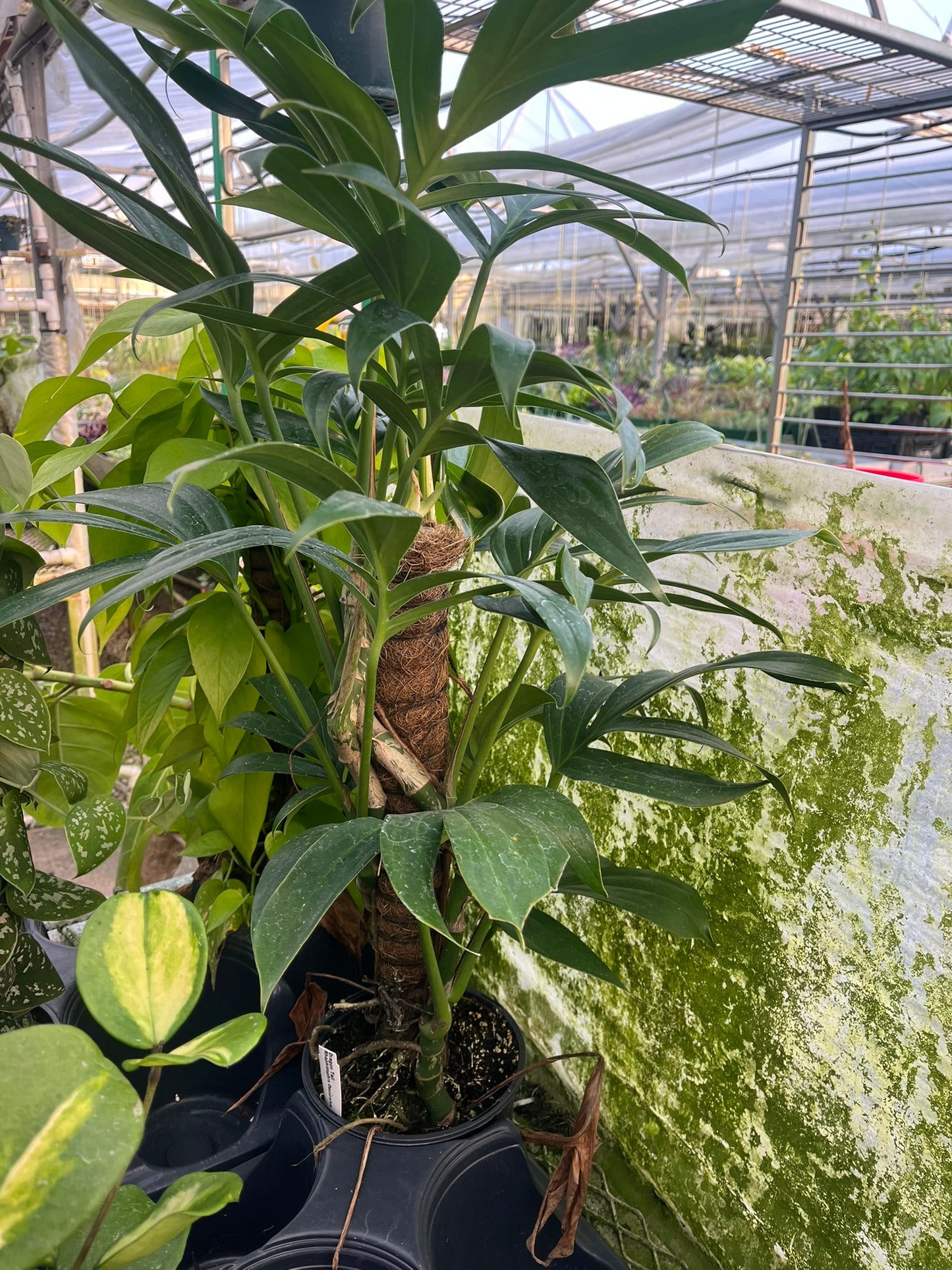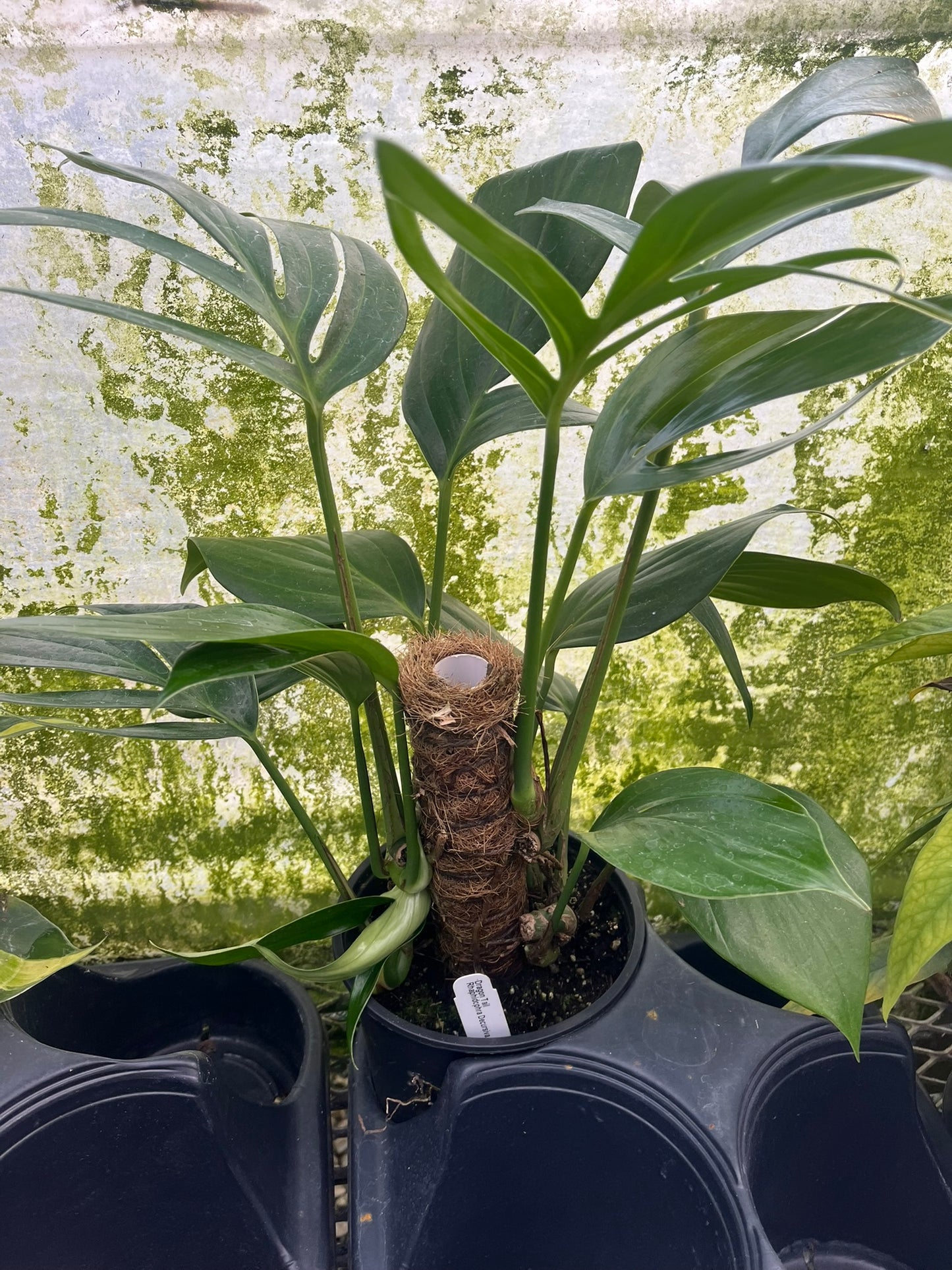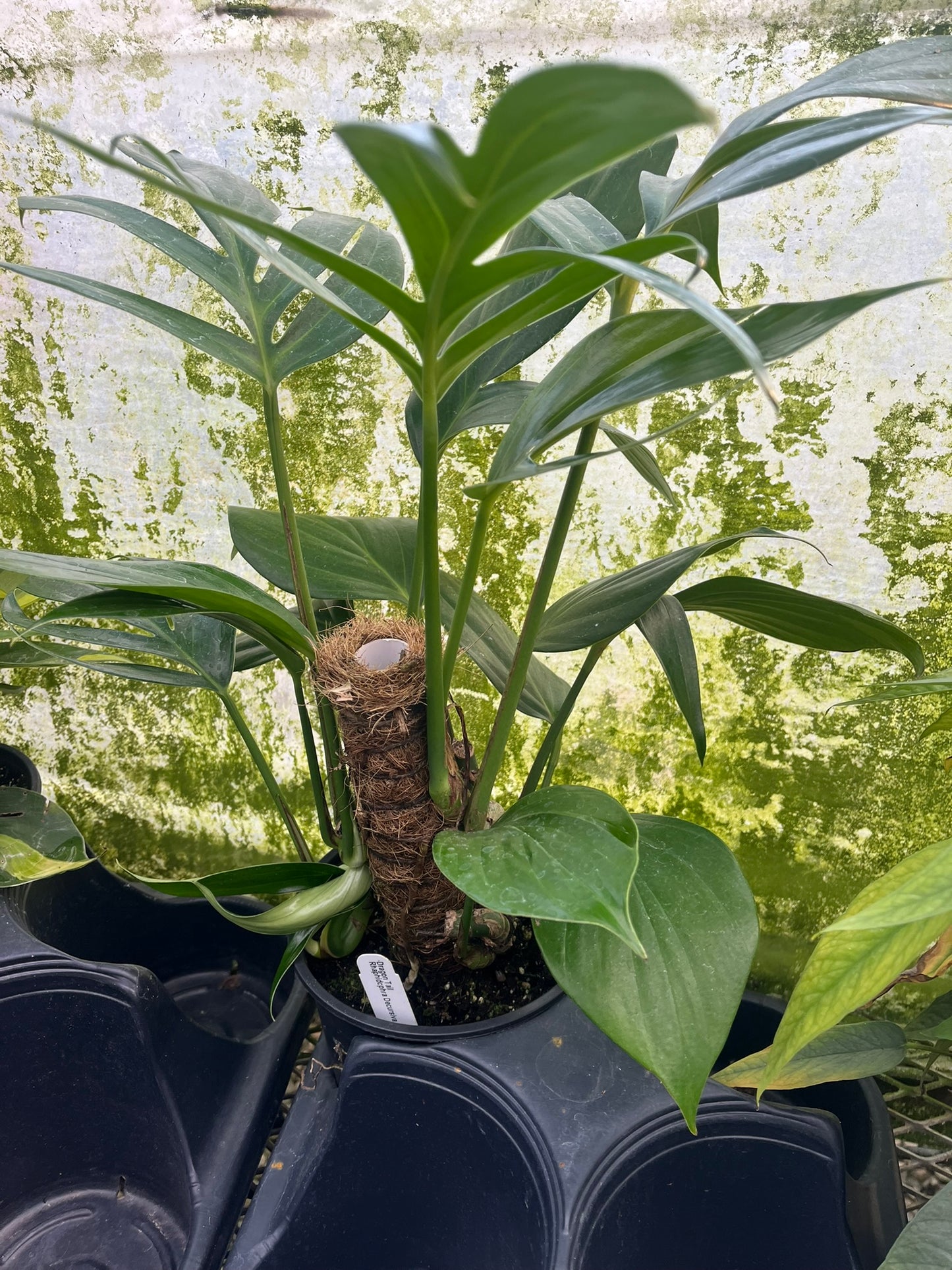Plant Hoarder
Rhaphidophora decursiva, Dragon Tail
Rhaphidophora decursiva, Dragon Tail
Couldn't load pickup availability
Share
Hardiness Zone:9
Sun Exposure:Part Sun, Mostly Shade and Shade
Rhaphidophora decursiva (Dragon Tail): Big, Bold, and Ready to Climb
Meet a tropical showstopper that grows with style. Rhaphidophora decursiva, also called Dragon Tail, starts with simple leaves. Then it matures into huge, deeply split fronds. The look is wild. The care is simple. In other words, you get grand, sculptural foliage without a fussy routine.
Why We Love Dragon Tail
We love plants that change as they grow. This one begins with smooth, narrow leaves. As it climbs and gains light, the leaves develop long cuts and deep lobes. The shape looks like a dragon’s tail in motion. It feels alive. It feels dynamic. But most of all, it turns any corner into a tropical scene.
Quick Facts (At a Glance)
-
Botanical name: Rhaphidophora decursiva
-
Common name: Dragon Tail
-
Growth style: Climber with aerial roots; can trail when young
-
Mature size indoors: 6–10+ ft with support
-
Light: Bright, indirect light
-
Water: When the top inch feels dry
-
Humidity: Moderate to high preferred
-
Pet safety: Not pet-safe if chewed
-
Skill level: Great for beginners
What Makes It Special
Dramatic Leaf Evolution
Juvenile leaves are simple. With height and light, they split and stretch. Each new leaf feels like a reveal. Instead of a static plant, you get a living sculpture that evolves in your home.
Fast Growth With Support
Give it a moss pole, coco pole, or sturdy trellis. The plant responds with stronger stems and bigger, more cut leaves. After more than a few weeks in good conditions, you’ll see faster, bolder growth.
Easy Routine, Big Reward
Bright, soft light. Airy soil. Consistent watering. That’s it. In other words, this is a high-impact plant that respects your time.
Light: Bright and Gentle Wins
Place near a window with bright, indirect light. Morning sun is fine. Midday sun can scorch. If light is too low, leaves stay small and may not split. Rotate the pot weekly for even growth.
Tip: A floor spot a few feet from an east or north window is perfect. Using a grow light? Keep it 10–14 inches above the leaves, 10–12 hours daily.
Water: Steady, Not Soggy
Water when the top inch of soil is dry. Pour slowly until water drains from the bottom. Empty the saucer. If leaves droop and the mix is dry, it’s time to water. If older leaves yellow and the mix stays wet, wait longer between waterings. Instead of watering on a calendar, use the touch test.
Humidity & Temperature: Cozy Air Helps
Normal home humidity works. 50%+ is even better for lush, wide leaves. A small humidifier or pebble tray helps. Keep temps 65–85°F. Avoid cold drafts and hot vents. Stable air keeps growth smooth.
Soil & Pot: Airy and Fast-Draining
Use an aroid mix that drains well and lets roots breathe. Try: potting soil + perlite + orchid bark. You can add a little coco coir for gentle moisture. Always choose a pot with drainage holes. Heavy, wet soil slows growth and risks root rot.
Feeding: Light and Regular
During spring and summer, feed with a balanced, gentle liquid fertilizer every 4–6 weeks. Go easy. Less is more. Pause feeding in late fall and winter when growth slows.
Repotting: Size Up Slowly
Repot every 12–18 months or when roots circle the pot. Increase pot size by 1–2 inches. Instead of jumping to a large pot, take small steps. Fresh mix and a bit more space keep roots active.
Training & Support: Unlock Bigger Leaves
Add a moss or coco pole early and keep it stable. Tie vines loosely with soft plant ties. As the plant climbs and anchors, leaves often get larger and more lobed. Want a cascading look? Let it trail from a shelf while young, then stake it later for that dramatic split-leaf stage.
Pruning & Shaping: Clean and Full
Trim long runners to keep the shape you like. Cut just above a node. Pruning encourages branching and a fuller plant. Wipe leaves with a damp cloth to remove dust and boost shine.
Propagation: Share the Dragon
-
Cut a healthy vine below a node with at least one leaf.
-
Root in water or an airy mix (perlite + bark + a little soil).
-
Keep warm, bright, and out of direct sun.
-
Roots form in a few weeks.
-
Pot up when roots are a few inches long.
In other words, it’s easy to multiply. Give one to a friend and start a jungle together.
Common Questions (Quick Answers)
Why aren’t the leaves splitting yet?
The plant needs more light and vertical support. Move it to brighter indirect light and add a pole. With time and height, splits follow.
Why are tips brown?
Usually dry air or underwatering. Boost humidity and water when the top inch is dry.
Why is growth slow?
Check light first. Warmer temps, a gentle feed, and an airy mix also help.
Is it pet-safe?
Like many aroids, it is not safe for pets if chewed. Keep it out of reach.
Where It Shines at Home
-
Living room focal point: Tall pole, big leaves, instant drama.
-
Bright office corner: Clean lines, calm energy, low fuss.
-
Warm bathroom: Extra humidity fuels lush growth.
-
Entryway statement: A narrow footprint with towering style.
Instead of filling space with many small plants, let one Dragon Tail anchor the scene. It sets the tone.
What You’ll Receive
-
A healthy Rhaphidophora decursiva with active growth
-
Potted in a nursery container for easy transfer
-
Natural variation in leaf size and lobing (each plant is unique)
(Note: Size and leaf count vary by season. Minor cosmetic marks are normal for living foliage.)
Care Checklist (Pin This)
-
Bright, indirect light
-
Water when top inch is dry
-
Aim for 50%+ humidity
-
Airy aroid mix with bark and perlite
-
Feed lightly in spring and summer
-
Provide a stable pole or trellis
-
Prune above nodes to shape and fill
-
Keep away from pets
Your First Week Plan
Day 1–2: Unbox gently. Check moisture. Water only if the top inch is dry. Place in bright, indirect light.
Day 3–5: Let it settle. Don’t repot yet. Wipe leaves and plan your support.
Day 6–7: Add a pole or trellis. Tie vines loosely. Light morning misting helps if your air is dry.
After more than a week, watch for fresh growth. New leaves unfurl. Splits deepen. You’ll smile every time you pass by.
Tiny Troubleshooting Map
-
Droop + dry soil: Give a deep, slow drink.
-
Droop + wet soil: Let it dry longer; check drainage.
-
Yellow older leaves: Often overwatering; adjust schedule.
-
Pale, small leaves: Needs brighter indirect light or gentle feeding.
-
Sun scorch: Move back from harsh rays.
Why Choose This Plant With Us
We select strong, well-rooted plants. We pack with care. We share clear steps that work in real homes. Instead of guesswork, you get support from day one. We want your Dragon Tail to thrive—and we’re excited to help.
Giant Leaves, Simple Steps








